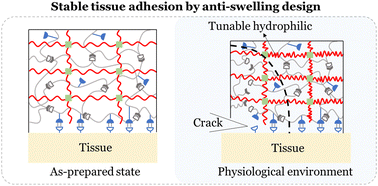A double-network strategy for the tough tissue adhesion of hydrogels with long-term stability under physiological environment†
Abstract
Achieving tough and stable tissue adhesion under a physiological environment is of great significance for the clinical applications of hydrogel adhesives. The current tough hydrogel adhesives face challenges in the preservation of the maximal adhesion for a long time due to swelling. Here, we propose a double-network strategy for tough tissue adhesion by a hydrogel with long-term stability under a physiological environment. A double-network hydrogel consisting of a covalently crosslinked primary network with tunable hydrophilicity and a non-covalently crosslinked secondary network with functional groups is designed. The primary network exhibited hydrophobicity in the physiological environment, which could constrict the secondary network and limit the swelling of the entire hydrogel. The secondary network could form strong interlinks with tissue and provide large energy dissipation through the unzipping of its noncovalent crosslinks when separated by a force. The combination of the two networks resulted in a tough and stable tissue adhesion. A poly(N-isopropylacrylamide)/calcium alginate hydrogel synthesized based on this strategy realized an adhesion energy of 300–500 J m−2 with porcine tissues, and the maximal adhesion could be maintained for over 1000 min after submerging in a PBS solution at 37 °C. The swelling behavior of the hydrogel and changes in mechanical properties under the physiological environment are studied, and its application in repairing the aorta wound is demonstrated.



 Please wait while we load your content...
Please wait while we load your content...